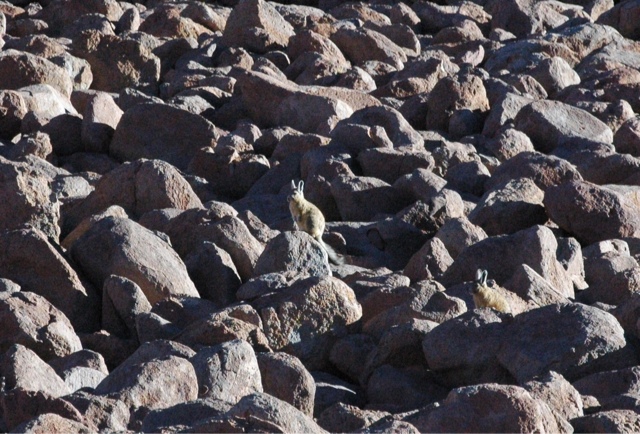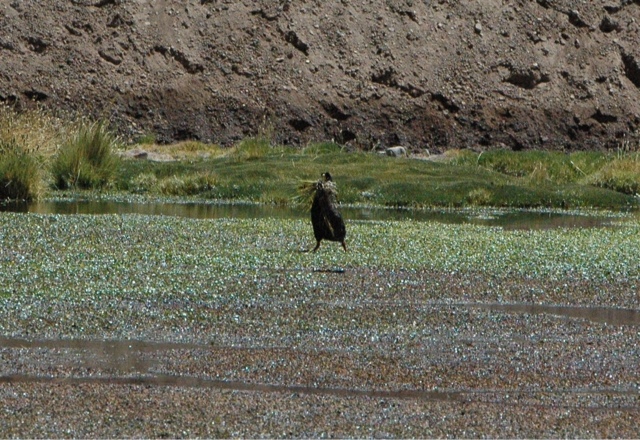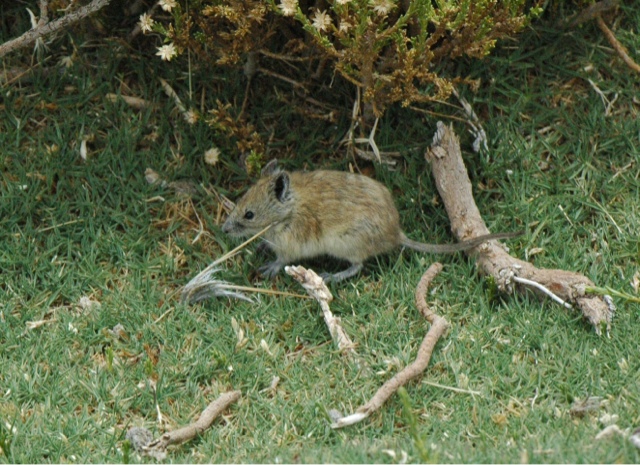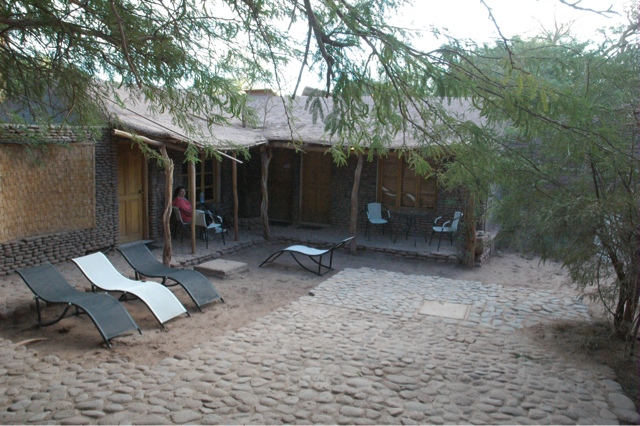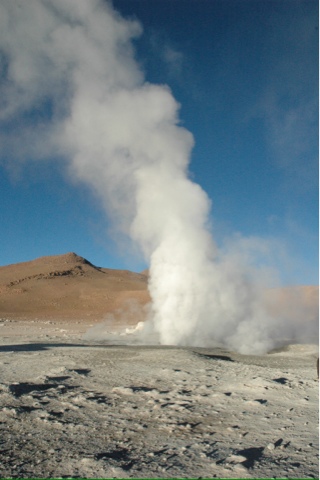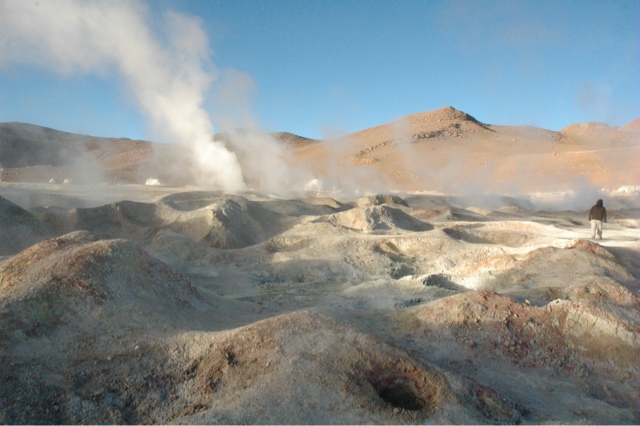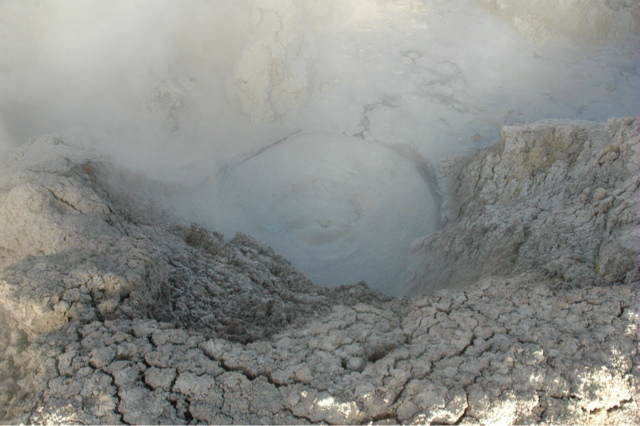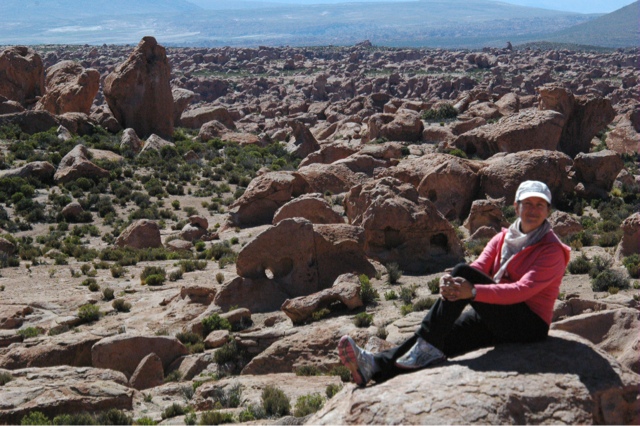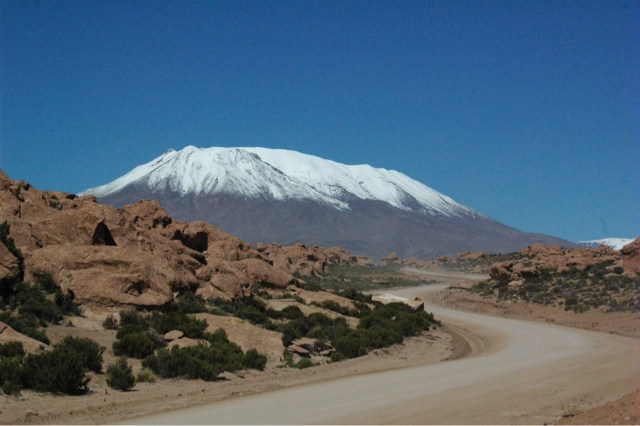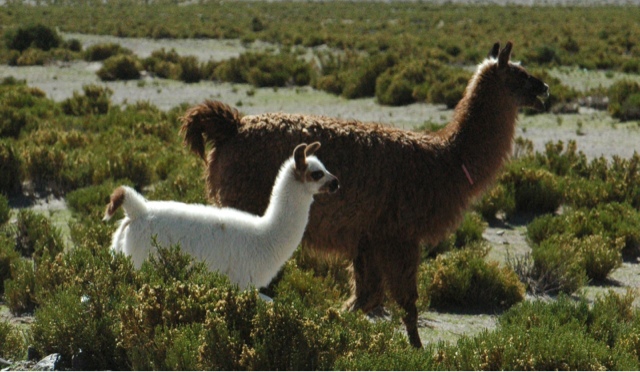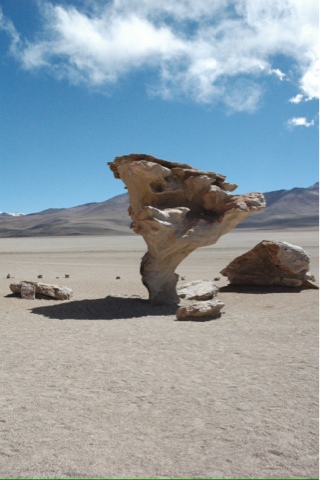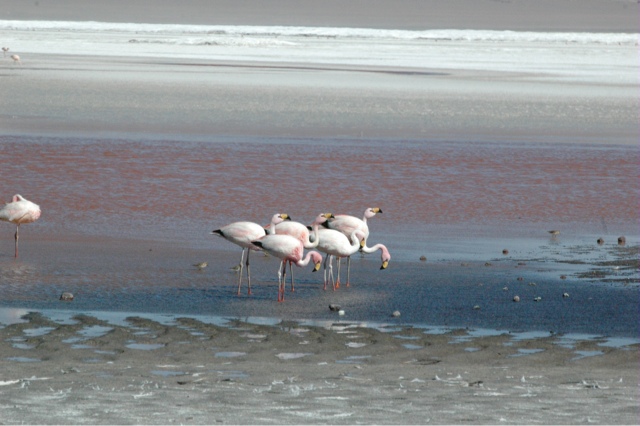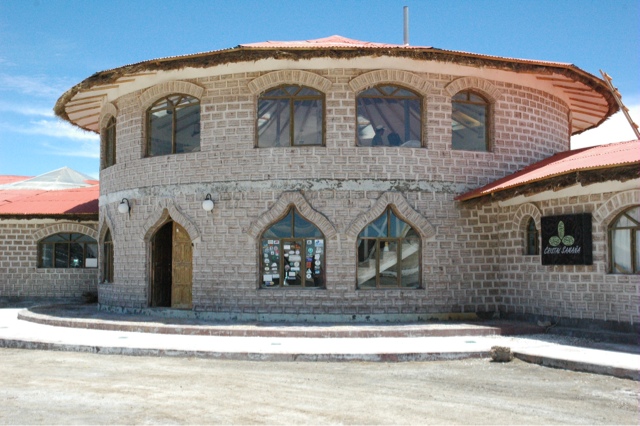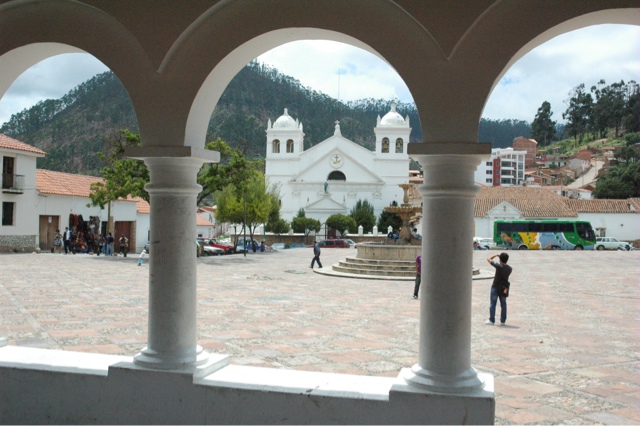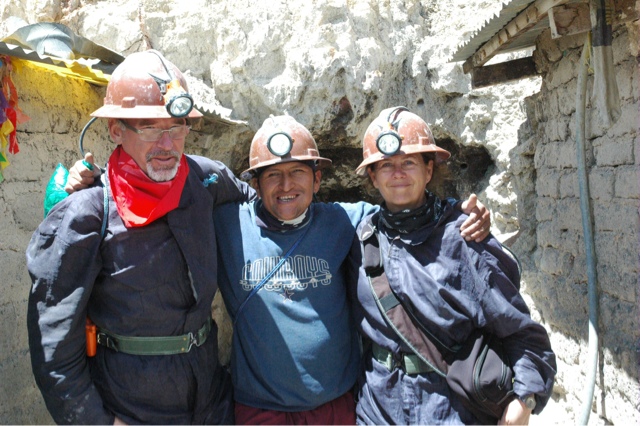We arrived on Sunday, January 27th just after mid-day. Our first task was to find a place to sleep for the next three nights. Once that was taken care of, we started booking some excursions. San Pedro de Atacama is a popular destination because of the driest dessert, high altitude lagoons and salt flats. It sounds a little like the trip we just took, but we thought it would still be worth a visit as we had such a good time during the past three days.
We experienced a little bit of a shock as the prices here are so much higher than in Bolivia. Not only for accommodations, but also the restaurants and the cost of the excursions. Good thing we didn't plan to be here for too long. We had been below our travel budget up till now and suddenly we are over-budget.
Our first day out, we were up at 4 am to visit the geysers. It was a long drive up into the Andes to an altitude of over 4,000 meters and it was a very frigid morning up in the mountains. Once the sun rose over the mountain, we started to warm up. These geysers were quite different from the ones we saw in Bolivia, so it was good to see and quite interesting.
Our guide was very knowledgeable about the geology and also showed us some interesting animals. We had already seen the Vicuña in Bolivia but we had never seen the Vizcacha which looks like a cross between a rabbit and a kangaroo but is the size of a large rabbit. You see one in the photos below amongst all the boulders. The next photo is of a Tagua Gigante. He is carrying a bunch of grass in his beak and waking across the wetland heading towards the nest he and his mate are building.
The afternoon trip was to the Valley of Death and Moon Valley. In the Valley of Death we stopped at Coyote Rock for a photo opportunity, walked through the valley and went down some huge sand dunes. At Moon Valley we waited for the sunset and watch the rocks turning nice colors of orange and red.
Our next two days adventures took us to a couple of highland lagoons, the salt flats, and some amazing rock formations in the desert. If we hadn't already been to similar sites in Bolivia I think we would have been greatly impressed. It is a beautiful part of the world and although more expensive, it is also slightly more sophisticated than Bolivia. Regardless which country you are in, being in the middle of the Andes gives you a feeling of space and serenity that is hard to beat.
It is now Wednesday and we are sitting waiting for our overnight bus to Arica, which is on the Pacific coast and will take us close to the border of Peru. We have done four excursions in three days and quite frankly, I am not looking forward to getting on another bus, let alone spending a night on one. But that's the life of economy travelling!
Wednesday, January 30, 2013
Tuesday, January 29, 2013
Getting to Know Bolivia : Salt Flats, Alpine Meadows, Lagoons and Deserts DAY 3
The 5am wake up call came a little too quickly after a night of King's Cup. But we all managed to be packed and ready to go on time. The morning temperature was just below freezing. The full moon was still visible and we were all waiting for the sun to come and warm us up.
We piled into the cars ready for another day of adventures. Destination number one - geysers. Even here in the Andes there are natural geysers and the best time to see them is when the steam is rising up because of the cold night air. It felt like we had somehow landed on another planet. The terrain was surreal with large open craters with bubbling mud and steam. You have to see it in person to fully appreciate it.
Now, with such an early start to the day, we were all ready for a little breakfast. We arrived to the hot spring pool at around 7 am, had breakfast and changed into our bathing suits as quick as possible to get into the water which was about 35 degrees c. There were Llamas all around the pools and with the steam rising from the water it looked so calm and beautiful. It was wonderful to get into the water and let the previous nights sins wash away. I was so busy relaxing that I completed forgot to take any photos.
Out of the pools and dressed again as we didn't have time to waste today. We had to get to the border crossing to Chile in time to catch our bus at 10:30 am. A brief stop at the green lagoon which wasn't very green that day. Let me explain the reason for the colors in the lagoons. It is a result of the algae living off the minerals that are washed out of the ground. The types of minerals dictate the type and color of the algae. And if there is no wind to stir up the water, you don't see the color.
At the border 'Team Flamingo' as we have been dubbed by Natalya, said their farewells. Those of us crossing the border to Chile got in line to get our exit stamps and the others had a long ride back to Uyuni. We would only have a 45 minute ride to our destination.
Next stop: San Pedro de Atacama, Chile
We piled into the cars ready for another day of adventures. Destination number one - geysers. Even here in the Andes there are natural geysers and the best time to see them is when the steam is rising up because of the cold night air. It felt like we had somehow landed on another planet. The terrain was surreal with large open craters with bubbling mud and steam. You have to see it in person to fully appreciate it.
Now, with such an early start to the day, we were all ready for a little breakfast. We arrived to the hot spring pool at around 7 am, had breakfast and changed into our bathing suits as quick as possible to get into the water which was about 35 degrees c. There were Llamas all around the pools and with the steam rising from the water it looked so calm and beautiful. It was wonderful to get into the water and let the previous nights sins wash away. I was so busy relaxing that I completed forgot to take any photos.
Out of the pools and dressed again as we didn't have time to waste today. We had to get to the border crossing to Chile in time to catch our bus at 10:30 am. A brief stop at the green lagoon which wasn't very green that day. Let me explain the reason for the colors in the lagoons. It is a result of the algae living off the minerals that are washed out of the ground. The types of minerals dictate the type and color of the algae. And if there is no wind to stir up the water, you don't see the color.
At the border 'Team Flamingo' as we have been dubbed by Natalya, said their farewells. Those of us crossing the border to Chile got in line to get our exit stamps and the others had a long ride back to Uyuni. We would only have a 45 minute ride to our destination.
Next stop: San Pedro de Atacama, Chile
Getting to Know Bolivia : Salt Flats, Alpine Lagoons, Deserts and Geysers DAY 2
Today was the day of lagoons and flamingos and amazing views of snow-capped mountains, meadows, deserts, weird rock formations and volcanoes. The sky was the most incredible shade of blue, the air was fresh and the color pallet of the land was beyond words with green, blue, white and beige hues all blended together. It was spectacular. And add into this mix the sight of pink and black flamingoes and you have a combination that is difficult to resist as my 400 and some photos will attest to that fact. We tried to pick just some of the best ones to share with you.
Our days travels took us further south to the Reserva Eduardo Avaroa close to the borders of Chile and Argentina. We had read that it is one of the most beautiful national parks in the world and we weren't disappointed.
After a day of driving and stopping for photos and lunch, we stopped at a cluster of hostels in the park. We were at 4,600 meters and with a clear sky and full moon, we knew it would get cold once the sun went down. This hostel was a little more basic with dorm rooms and shared bathrooms. Our group took over one hostel, making it quite cozy. Being with a group of young backpackers it was inevitable that we would finish the evening with a drinking game, this one called King's Cup. After about fifteen bottles of wine, we turned out the lights and snuggled into our sleeping bags. We were due to be up at 5:00 am for our last day in the park.
Our days travels took us further south to the Reserva Eduardo Avaroa close to the borders of Chile and Argentina. We had read that it is one of the most beautiful national parks in the world and we weren't disappointed.
After a day of driving and stopping for photos and lunch, we stopped at a cluster of hostels in the park. We were at 4,600 meters and with a clear sky and full moon, we knew it would get cold once the sun went down. This hostel was a little more basic with dorm rooms and shared bathrooms. Our group took over one hostel, making it quite cozy. Being with a group of young backpackers it was inevitable that we would finish the evening with a drinking game, this one called King's Cup. After about fifteen bottles of wine, we turned out the lights and snuggled into our sleeping bags. We were due to be up at 5:00 am for our last day in the park.
Getting to Know Bolivia : Salt Flats, Alpine Lagoons, Deserts and Geysers DAY 1
We left Uyuni on January 25th, jumped into a jeep with five other people and headed off into the wilderness. The tour we signed up for had two jeeps, two drivers, of course, one guide and 11 adventurous and eager backpackers. Amongst us we counted 4 Aussies, 2 Kiwis, 2 gringos, 1 Limie, a Canuk and a Viking. In case you were wondering, Jens and I were the oldest in the group by about 20 years. I guess people our age don't do these kinds of trips??
Our first stop was the train cemetery. These were old steam locomotives that had been abandoned when they were replaced by diesel locomotives back in the 50's. They had been stripped of all valuable items and were to be sold for scrap, but over the years the transactions never materialized. They have now become part of the landscape and a favorite stop on the tours.
Then it was off to the salt flats. This is the rainy season (or so they say, cause we haven't seen rain since we left La Paz) so the salt flats had about 15-30 cm of water on them. The salt flats in Uyuni are the largest in the world. They are the result of the earth's plates shifting up creating a new mountain range and trapping part of the sea between the land. Over the millenniums the water evaporated leaving behind a hard layer of salt more than one meter thick that spreads out as far as the eye can see. We had lunch at a hotel made of salt bricks and then we drove out to the salt flats to stand in the water and experience the vastness of this phenomenon.
In the dry season we would have stayed at a hostel on an island in the salt flats but with all the water it was not accessible. Instead we went around the flats and continued our journey traveling south to a small town in the middle of the desert. We passed lots of llamas roaming wild, fields of quinoa and the odd group of vicuña. Vicuña are a wild camelid, smaller than an alpaca with a more slender profile and an incredibly soft coat. They are a protected species and although we could buy the hide in Peru, it is extremely expensive and you need a certificate to bring it out of the country. They say the wool is the rarest in the world.
The hostel was a one floor mud brick construction, very basic but clean and functional. We had our own room with ensuite toilet. Snacks and dinner and a fun evening with the help of a little beer and wine and a boisterous game of UNO before we called it a night.
Our first stop was the train cemetery. These were old steam locomotives that had been abandoned when they were replaced by diesel locomotives back in the 50's. They had been stripped of all valuable items and were to be sold for scrap, but over the years the transactions never materialized. They have now become part of the landscape and a favorite stop on the tours.
Then it was off to the salt flats. This is the rainy season (or so they say, cause we haven't seen rain since we left La Paz) so the salt flats had about 15-30 cm of water on them. The salt flats in Uyuni are the largest in the world. They are the result of the earth's plates shifting up creating a new mountain range and trapping part of the sea between the land. Over the millenniums the water evaporated leaving behind a hard layer of salt more than one meter thick that spreads out as far as the eye can see. We had lunch at a hotel made of salt bricks and then we drove out to the salt flats to stand in the water and experience the vastness of this phenomenon.
In the dry season we would have stayed at a hostel on an island in the salt flats but with all the water it was not accessible. Instead we went around the flats and continued our journey traveling south to a small town in the middle of the desert. We passed lots of llamas roaming wild, fields of quinoa and the odd group of vicuña. Vicuña are a wild camelid, smaller than an alpaca with a more slender profile and an incredibly soft coat. They are a protected species and although we could buy the hide in Peru, it is extremely expensive and you need a certificate to bring it out of the country. They say the wool is the rarest in the world.
The hostel was a one floor mud brick construction, very basic but clean and functional. We had our own room with ensuite toilet. Snacks and dinner and a fun evening with the help of a little beer and wine and a boisterous game of UNO before we called it a night.
Wednesday, January 23, 2013
Getting to know Bolivia : Sucre and Potosi
SUCRE:
We left La Paz on an overnight bus headed to Sucre, the nation's capital. The travel agent told us he had booked upon 'the best' full cama (meaning seats that fully recline) bus company available and we were happy to pay a little extra for the comfort.
Well, I won't bore you with the details other than to say the windows were drafty, making it not only a strange night but very cold night. If this was the best choice, i would hate see what the other buses were like. Bolivia is the poorest country in South America and it shows in the transportation and the road conditions.
The good thing is Sucre is in a valley and this is the lowest in altitude and the warmest we have been since Cusco. The Cholitas wear slightly shorter skirts here and hats that are either made of straw or resemble a small cowboy hat. The town was pretty enough and as we set out to explore the sights we discovered that it was some kind of impromptu holiday and most everything was closed. We had a leisurely lunch and started chatting with a couple and their three children who are traveling around South America in their car. And wouldn't you know it, they're from Odense, Denmark. We spent most of the afternoon exchanging stories of our travels and soon became fast friends promising to visit each other when we get home again.
So, the last few days Jens has been confused about which country and city we are in. I know with all our travelling it is difficult to keep track and I myself was often saying we were in Lima when I meant to say we were in Peru. But both are four letter words ending in a vowel, so you can understand how I could get them mixed up. It's a little harder to explain how Jens could post on Facebook today that we were in Columbia. We haven't been there since last April! It must be all the extra oxygen his brain is getting at these lower altitudes.
The next day we visited the textile museum and were properly impressed with their fine art of weaving with complicated designs dating back centuries. We ambled through town, picked up a lunch to go at a cafe and headed to the bus station. Now it's back to higher altitude and cold once again.
POTOSI
We arrived to Potosi late yesterday afternoon after a three hour bus trip which took us through valleys then climbed up to some highland pastures at around 3,300 meters before reaching our destination at 4,100 meters. Lucky for us the sun came out for a last hurrah and we have a beautiful sunny day today. Potosi is famous for its silver mine which is still in operation today although the mother lode has long been extracted, some 45,000 tonnes most of which found its way to Spain.
The mining now is much more difficult and the veins of silver smaller and fewer. The extraction is still all done by hand, the conditions are horrific and the life expectancy of a miner is somewhere around mid-40's. We saw a boy of 10 years working in the mine today with his father. He was preparing the dynamite, which you can buy in a local shop by the way, along with ammonium nitrate, fuses and detonators.
The miners work in a cooperative so they benefit from what is extracted which is now mostly zinc, lead and tin. They all get into mining because it pays more than working in the city. Our tour guide was an ex-miner who worked for 20 years before realizing he was not going to be one of the lucky ones to strike it rich. They are a very superstitious people and have statues of the devil god Tata Kajchu underground and give offerings to him and to Pachamama (Earth Mother). As we were sitting in an alcove underground listening to our guide, Wilson's stories, we heard and felt several blasts of dynamite going off. Seeing that the safety measures in this mine were non-existent, it was a really scary feeling and it was all I could do to stop myself from running out of there as fast as I could. The only thing stopping me is I was afraid I would get lost.
It was a heck of an experience. Shocking to see that they work without safety goggles, masks, boots or even gloves. There seems to be no order or structure when it comes to blasting and despite all this, we were told that only 12 miners died in the mines last year.
I won't ever take for granted the luxuries we have at home after this and I doubt I'll go down into another mine either.
We left La Paz on an overnight bus headed to Sucre, the nation's capital. The travel agent told us he had booked upon 'the best' full cama (meaning seats that fully recline) bus company available and we were happy to pay a little extra for the comfort.
Well, I won't bore you with the details other than to say the windows were drafty, making it not only a strange night but very cold night. If this was the best choice, i would hate see what the other buses were like. Bolivia is the poorest country in South America and it shows in the transportation and the road conditions.
The good thing is Sucre is in a valley and this is the lowest in altitude and the warmest we have been since Cusco. The Cholitas wear slightly shorter skirts here and hats that are either made of straw or resemble a small cowboy hat. The town was pretty enough and as we set out to explore the sights we discovered that it was some kind of impromptu holiday and most everything was closed. We had a leisurely lunch and started chatting with a couple and their three children who are traveling around South America in their car. And wouldn't you know it, they're from Odense, Denmark. We spent most of the afternoon exchanging stories of our travels and soon became fast friends promising to visit each other when we get home again.
So, the last few days Jens has been confused about which country and city we are in. I know with all our travelling it is difficult to keep track and I myself was often saying we were in Lima when I meant to say we were in Peru. But both are four letter words ending in a vowel, so you can understand how I could get them mixed up. It's a little harder to explain how Jens could post on Facebook today that we were in Columbia. We haven't been there since last April! It must be all the extra oxygen his brain is getting at these lower altitudes.
The next day we visited the textile museum and were properly impressed with their fine art of weaving with complicated designs dating back centuries. We ambled through town, picked up a lunch to go at a cafe and headed to the bus station. Now it's back to higher altitude and cold once again.
POTOSI
We arrived to Potosi late yesterday afternoon after a three hour bus trip which took us through valleys then climbed up to some highland pastures at around 3,300 meters before reaching our destination at 4,100 meters. Lucky for us the sun came out for a last hurrah and we have a beautiful sunny day today. Potosi is famous for its silver mine which is still in operation today although the mother lode has long been extracted, some 45,000 tonnes most of which found its way to Spain.
The mining now is much more difficult and the veins of silver smaller and fewer. The extraction is still all done by hand, the conditions are horrific and the life expectancy of a miner is somewhere around mid-40's. We saw a boy of 10 years working in the mine today with his father. He was preparing the dynamite, which you can buy in a local shop by the way, along with ammonium nitrate, fuses and detonators.
The miners work in a cooperative so they benefit from what is extracted which is now mostly zinc, lead and tin. They all get into mining because it pays more than working in the city. Our tour guide was an ex-miner who worked for 20 years before realizing he was not going to be one of the lucky ones to strike it rich. They are a very superstitious people and have statues of the devil god Tata Kajchu underground and give offerings to him and to Pachamama (Earth Mother). As we were sitting in an alcove underground listening to our guide, Wilson's stories, we heard and felt several blasts of dynamite going off. Seeing that the safety measures in this mine were non-existent, it was a really scary feeling and it was all I could do to stop myself from running out of there as fast as I could. The only thing stopping me is I was afraid I would get lost.
It was a heck of an experience. Shocking to see that they work without safety goggles, masks, boots or even gloves. There seems to be no order or structure when it comes to blasting and despite all this, we were told that only 12 miners died in the mines last year.
I won't ever take for granted the luxuries we have at home after this and I doubt I'll go down into another mine either.
Subscribe to:
Posts (Atom)





